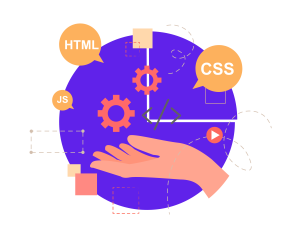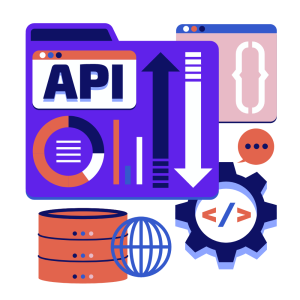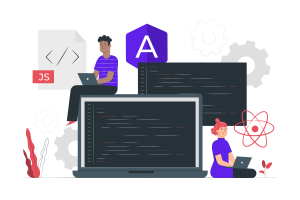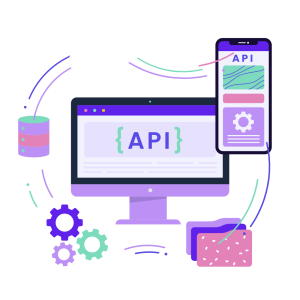24.08.2022
WordPress Development
WordPress & Microservices: The Best Architecture for Enterprises
READING TIME: MIN
Table of Content
Do you know what web giants like Netflix, Uber, eBay, Amazon and Spotify have in common? They are all leveraging the power of the so-called ‘microservices architecture’.
In fact, in the last few years, more and more enterprise organisations are ditching the restrictive monolith architecture and are heading toward a flexible microservice-based structure.
Our WordPress Agency for Development is not at all surprised by this shift in the tech and web development world. After all, this is a world where flexibility and reliability are everything.
The microservices approach splits software into independent services capable of collaborating with one another. This is way better than developing it as a single integrated system. With a microservices architecture, the product is easier to scale and less likely to collapse.
Sounds compelling? Read on to learn more about microservices and the advantages they provide for digital products and services!

Out With the Old, in With the New: Monolithic vs Microservices
Our WordPress development agency reminds you that containerization and cloud computing are two things that define the current tech era. And in these modern days, monolithic systems fall short. The reason? Software systems are becoming more sophisticated with each passing day.
With this growing complexity of technology, the construction and upkeep of monolithic systems are getting more and more challenging.
In a monolithic system, every component is created and assembled into a single unit (these components include a client-side user interface, server-side operations, and a database). This means that the entire system would need to be redeployed each time a single component is changed. Obviously, this is far from ideal as it makes scaling more difficult and less flexible.
Thankfully, our WordPress Agency for Development can assure you that the microservices architecture can successfully address all problems associated with the traditional monolithic approach.
[ad_show]
With a microservices architecture, the system is divided into smaller, independent components. Here, we’re talking about a collection of independent services built around a single business domain. The biggest perk is that each of these individual units can handle one aspect of the software’s functionality.
Our WordPress development agency wants you to remember that microservices are fundamentally a part of the DevOps culture, which emphasises strong collaboration between development and IT operations teams and the use of automation tools to produce results more quickly.
With all of that being said, let’s break down the two approaches – monolithic vs microservices architecture – into bullet points. This way, you can more easily remember the main differences between the two.

Monolithic architecture:
- A monolithic architecture is characterised by a single codebase that encompasses all functionality.
- A monolithic architecture is tightly coupled.
- A monolithic architecture utilises centralised data.
Microservices architecture:
- Microservices are autonomously developed.
- Microservices use their own database.
- Microservices can be developed in several languages.
- Microservices use lightweight protocols like HTTP, message brokers, or event streaming to communicate via APIs.
- Each microservice executes a certain business function.
Examples of Monolithic vs Microservices Architecture
Now that we made that distinction clear, our WordPress Agency for Development would like to give you two simple examples that illustrate how each of the two types of architecture work. For this purpose, we’ll use a hypothetical eCommerce application:
- eCommerce application with a monolithic architecture: A monolithic approach to developing an eCommerce application would result in tightly integrated front-end and back-end services being deployed as a single entity. If you want to make any customizations, you’ll need to make changes to both the codebase and the front-end platform.
- eCommerce application with a microservices architecture: A microservices approach to developing an eCommerce application means that independent services would be in charge of user profiles management, product images, searching, inventory verification, payments processing, and shipping. Our WordPress development agency recommends this approach since it lets you customise and administer the back-end (the business-facing part of the website) separately from the front-end (the customer-facing side of the website). This is super convenient for large-scale enterprise organisations.
So Monolith Is the Villain, and Microservices Is the Hero?
Look, we’re not here to tell you that monolithic applications are to be avoided at all costs. On the contrary, these types of applications are still prevalent in many industries, and they can be a good option for certain use cases.
However, in the context of enterprise companies, the monolithic approach is simply lacking in terms of scalability and flexibility – two things that are absolutely essential for future growth.
Our WordPress Agency for Development knows very well that enterprises don’t like to be faced with unresolvable drawbacks and this is why they’re turning away from the monolithic architecture.
Remember that with the monolithic approach, rebuilding and redeploying the complete system is frequently necessary when changing one component (whether for upgrading or scaling reasons).
Not to mention that with this type of architecture, just one malfunctioning component can bring the entire system down. Additionally, monoliths are very challenging to manage as they expand, and integrating with third-party tools can be a nightmare.
In the turbulent market environment of today, when organisations must respond quickly to changes to survive and prosper, these negatives are difficult to overlook. This is why our WordPress development agency recommends the microservices approach to any company that wishes to stay ahead of the game and make a splash on the market.

The 5 Fundamental Elements of Microservices
Given that a microservices architecture is dispersed over several functions, technologies, and servers, you might be questioning how the coordination between different units happens.
This is the right time to introduce you to the five core components of all microservices architectures:
1. Microservices
It should come as no surprise that the self-contained microservices themselves are the first important aspect of a microservice architecture. The size of a microservice depends on the conditions and demands.
Our WordPress Agency for Development reminds you that the main goal is to minimise dependencies and decouple services from one another. This is usually done via REST or HTTP APIs that help the various units communicate with each other.
2. Containers
Containers make it simpler to build, test, and deploy software in any environment, whether it’s a public cloud, a private data centre, or a developer’s laptop. Containers are units of software that package code and its dependencies in a single block.
Containers are a frequent component in microservices architecture, however, they are not absolutely necessary. They enable scaling and package deployment without impairing the performance of the application or digital product.
Our WordPress development agency wants you to remember that when used in conjunction with Kubernetes, container management solutions like Docker can help unify the setup of microservices and enable scalable management of container clusters.
3. Service Mesh
The service mesh is an architecture layer that makes it possible for various microservices to communicate with one another.
4. Service Discovery
Service discovery is essentially the process of keeping track of the service instances that are currently in use inside the architecture of an application or other product. Service discovery monitors and distributes load among the different microservices as the deployment changes.
Service discovery consists of three components that our WordPress Agency for Development wants you to keep in mind:
- Service Provider: Originating service instances.
- Service Registry: Storing the location of the service instances.
- Service Consumer: Using locations from the registry to communicate with service instances.
5. API Gateway
Application Programming Interfaces (APIs) specify and streamline communication between microservices and external clients. The API gateway handles a large portion of the communication, administration, and security, while ensuring the microservices remain as lightweight as possible.
Our WordPress development agency has covered the REST API functionality of WP before on our blog for those who are interested to learn more:
- REST API: The Greatest Superpower of WordPress
- Applications of REST API in WooCommerce
- How to Retrieve Data From WordPress With REST-API And GraphQL
- API-First Approach to WordPress Development
Here’s How the Microservices Architecture Can Benefit Enterprise Organisations With WordPress-Based Websites and Applications
As we already said, many organisations on a global scale are moving their monolithic-based applications to microservices. This is not surprising at all, given the fact that some of the biggest players in the web arena have already realised the benefits of a microservices architecture.
If, however, you’re still unsure as to whether applying the microservices architecture will be a good idea for your business, you can check out the below points where our WordPress Agency for Development lists some of the biggest advantages that microservices have to offer.
Enhanced Scalability
Individual microservices can be added, removed, updated, and scaled fairly easily because each one has the ability to function independently. What’s awesome about this is that the other microservices that make up the application can continue operating normally until you’re done modifying the one you want.
In a nutshell, this means that you only need to upgrade or direct extra resources to the microservice that is being impacted by, let’s say rising demands. Remember that this is not possible with a monolithic approach where you’ll have to redeploy the entire system in order to change just one component.
Our WordPress development agency reminds you that with a microservices architecture you can take advantage of container orchestration tools. When properly calibrated, these tools can automatically scale individual microservices. This is usually done by allocating more processing power or creating new instances of microservices.
Enterprises can significantly reduce their expenditures on cloud server resources by only scaling the services that require it. All of this makes the microservices architecture a highly scalable solution fitted for enterprise-level businesses.

Redefining Resiliency With Better Fault Isolation
Because each microservice operates independently from the others in a microservices architecture, the failure of one service is less likely to have an adverse effect on other components of the application.
However, our WordPress Agency for Development needs to note that because big distributed microservices architectures frequently have several dependencies, developers must safeguard the application against a shutdown caused by a dependency failure.
This shouldn’t be an issue, though, as developers can prevent cascading failures with features like ‘circuit breaker’. Such features act as a prevention for server resource depletion if a calling service must wait on hold for a broken service that never responds.
Developers can also use Hystrix to build fault-tolerant microservices. Hystrix is an open-source solution developed by Netflix to prevent cascading failure and improve the resilience of its own infrastructure.
Our WordPress development agency likes this latency and fault tolerance library because it segregates points of access to remote systems, services, and third-party libraries. It also prevents cascading failure and provides resilience in complex distributed systems where failure is unavoidable.

Get To Choose the Programming Languages and Technology Stack
Developers can connect microservices written in any programming language while building a microservices-based application. Not only that, but microservices operating on different platforms can also be connected.
This gives you more freedom to utilise the programming languages and technologies that best suit the project’s requirements and the team’s skill sets. Our WordPress Agency for Development reminds you that such freedom simply isn’t possible with a monolithic approach.
What’s more, with a microservices architecture, users of cloud-based microservices applications can access the applications from any device that is connected to the Internet.
Improved Data Compliance and Security
The microservices architecture is generally considered one of the best approaches when it comes to protecting sensitive data. However, information security becomes a consideration when developers set up data connections between the microservices.
Fortunately, the majority of developers connect microservices using safe APIs. By ensuring that only servers, users, and apps with the appropriate authorization have access to the data it processes, a secure API protects the information it handles.
Our WordPress development agency is aware that your microservices might be managing sensitive financial, health, or other types of confidential information. You shouldn’t worry, though, as a secure API allows developers total control over what data is visible to the larger application and others who use it. This makes complying with HIPAA, GDPR, and other data security regulations way simpler.

Future-Proof Solution With a Faster Time to Market
By definition, an application built with a microservices architecture is pluggable. This makes these types of applications faster to develop and upgrade. Microservices can be easily created or modified by developers, and they can then integrate them into the architecture with reduced danger of coding conflicts and service interruptions.
Additionally, our WordPress Agency for Development reminds you that with a microservices architecture development teams don’t have to wait for slower-moving projects to be completed before they can launch their portion of the application. This is possible because each microservice is independent.
Another worth-noting thing about microservices is that they support the CI/CD/CD (Continuous Integration, Continuous Delivery, Continuous Deployment) development approach. What does this mean? It means that you can instantly deploy the core microservices of an application as a minimum viable product (MVP).
From there, you can continuously update the product as you add even more microservices over time. Our WordPress development agency believes enterprises can greatly benefit from this as they can swiftly address security issues and incorporate new, innovative technology as it emerges. The end result is a future-proof solution that is always evolving to fit the needs of the user.

Enhanced Business Agility and DevOps Support
Let’s be honest – experimenting with new features and technologies can be very exciting, but it also poses risks for the business as no one can guarantee whether or not the newly implemented features will turn out successful. However, a microservices-based architecture can ease these concerns.
Because with a microservices architecture it’s simple to test out new features and undo them if they don’t work out, large-scale enterprise organisations are better able to adapt to changing customer needs and market demands without worrying about vendor or technology lock-in.
Our WordPress Agency for Development wants to stress once more that agility is probably the biggest benefit of a microservices architecture. The ability to iterate on a tiny, focused piece of functionality quickly, and to see results can greatly benefit the growth of enterprises.
What’s more, microservices support the DevOps philosophy. A microservices architecture enables enterprise companies to quickly develop and launch new features, which makes it possible for end-users to see the impact of their feedback in weeks rather than months or years.
In a nutshell, this encourages user, developer, and engineer collaboration, which maximises user satisfaction and retention.

Microservices Go Hand in Hand With Two-Pizza Development Teams
Our WordPress development agency loves the fact that Amazon – one of the first pioneers of microservices – utilised this architectural approach to support the so-called “two-pizza development team rule”.
If you’re not familiar with this concept, it basically entails the idea that teams should be kept small enough to be fed by two pizzas. According to Amazon, the two-pizza rule:
- Increases productivity.
- Facilitates management of teams.
- Results in quicker goal completion.
- Leads to increased focus.
- Delivers products of a higher calibre.
Each microservice can be managed by a small team, which allows the teams to collaborate more closely, maintain alignment, stay focused, and be more accountable for their work.
Our WordPress Agency for Development is a big proponent of the “two-pizza development team rule” because it reinforces effective communication among team members.
Enterprise businesses can benefit greatly from having smaller groups of people who work together. Remember that it’s easier to develop relationships, trust, and motivation within a small team, which results in better work output.

Challenges Associated With a Microservices Architecture
Microservices are quickly replacing traditional approaches for creating applications because of their undeniable benefits. However, the implementation process is made more difficult by a few challenging factors.
The following are the main hurdles that enterprises and development teams should keep in mind when transitioning to a microservices architecture:
Migration of the Monolithic Database to Microservices
Our WordPress development agency reminds you that once you make the decision to split the monolith into microservices, the monolithic database must also be split into pieces. Remember that if several services are still connected to the same database tables, problems may arise.
For instance, there is a risk that any modification performed in one service can cause cascading changes in other microservices. This obviously defeats the entire purpose of utilising microservices, so migrating the monolith database to microservices becomes imperative. As challenging as this process may seem, an expert team of developers should be able to perform the task with confidence.
Managing Distributed Systems
Microservices’ distributed nature is both an asset and a source of worry for enterprises and developers alike. Our WordPress Agency for Development reminds you that creating a functional distributed system is no easy task, and so your dev team must keep in mind that maintaining such infrastructure communication would be more complex.
The dependencies between microservices need to be carefully handled so that there is minimal disruption when the different services communicate with one another.

Increased Resource Use and Variety in Technology
As we already said, each and every microservice team is permitted to choose the development and deployment technologies they want to utilise. As a result, there is a lot of technological variation inside a single project, which makes microservices more challenging to develop and maintain than monoliths.
Having that in mind, our WordPress development agency advises enterprises to make certain they can always rely on an expert team of developers who can take care of ongoing operations and maintenance of each implemented service. It’s true that this can lead to greater infrastructure expenses, but it is the only way to ensure that things will run smoothly.
Bigger DevOps Complexity
An experienced DevOps engineer or team is absolutely essential for the proper functioning of a microservices ecosystem. Remember that the upkeep of applications built with a microservices architecture is quite complicated.
In addition to the extra work required by developers to establish communication methods across the services, a high level of knowledge is needed to effectively manage all these moving components.
Our WordPress Agency for Development reminds you that since numerous programming environments, languages, and data structures are likely to be involved, development and operations must be managed by highly competent technical professionals.
Global Testing and Debugging
Comparatively speaking, testing monolithic software is much easier than testing microservices-based software. With the traditional monolithic approach, all you need to do is launch your application, and test its connectivity with the underlying database.
However, with applications built using microservices, you have to launch and test each service separately. And once all the services have been launched, the application in its entirety needs to be tested once again.

Expert Tips for Implementing a Microservices Architecture
Our WordPress development agency knows that transitioning from a monolithic architecture to microservices can be pretty challenging. However, the benefits of the microservices approach should outweigh any doubts and concerns that might bother you.
We advise all large enterprises to boldly make the switch to microservices. And below, we’ll share some expert tips that will help you implement a microservices architecture within the products and services of your business.
Know Your Business Objectives
Identifying whether your company requires this technology is the first step in implementing a microservices architecture. Large-scale enterprise organisations that perform numerous processes daily can benefit the most from the use of microservices.
Ensure That You Have Gathered a Team That Understands the Task at Hand
Our WordPress Agency for Development wants to stress that before writing the initial lines of code, every member of your team must have the necessary background knowledge and expertise in areas like data modelling, asynchronous programming, and API development. Only then will the implementation of a microservices architecture go smoothly.

Pick the Right Programming Languages
Developers can use a variety of coding languages and frameworks when building applications with a microservices architecture. This is why it’s imperative to spend some time discussing the technological stack for your product’s mobile or online development.
Make Data Storing a Priority
Our WordPress development agency reminds you that the database is a vital component of every application. This is why we advise you to create a plan to divide the database into a few small DBs as you move away from the traditional, monolithic architecture.
Apply Agile Methodology
When it comes to migrating to microservices, you will need small teams who employ the Agile methodology. So if you have one big development team, reorganise them into several smaller teams that work autonomously.
Remember that the implementation of microservices necessitates taking into account all potential pitfalls. Your team and the strategies you use will be crucial to the transition’s success.
So our WordPress Agency for Development advises you to plan everything super carefully, and use the best practices associated with project management. This way, the work will be synchronised properly and the results will be stellar.

Some Data Backing up the Benefits of a Microservices Architecture
IBM conducted a survey called “Microservices in the enterprise, 2021: Real benefits, worth the challenges”, which offers great insight into the real-world opportunities and challenges for implementing a microservices development approach. IMB surveyed more than 1,200 IT executives, developer executives and developers from large and midmarket companies.
According to the findings of IBM’s survey, users reported that microservices are helping their businesses in many different ways. They considered the following advantages to be the most crucial:
- 30% – Higher customer satisfaction/retention.
- 29% – Better security of company/customer data & Faster time to market/responding to changes in the marketplace.
- 28 % – Improved application quality/performance.
- 27% – Greater flexibility to scale resources up or down.
- 26% – Improved employee productivity & Improved application security.
Microservices Success Stories
Our WordPress development agency can assure you that the Internet abounds with success stories about how various business titans have migrated their infrastructures to microservices and have since scaled their performance to new heights.
Some of the most notable companies that have experienced the positive outcomes of adopting a microservices architecture include:
- Amazon
- eBay
- Netflix
- PayPal
- Uber
- Coca-Cola
- Spotify
Netflix, in particular, is very articulate and open when it comes to how they approach the transition from monolithic to distributed services and the technology they employ. Some great details about the whole process can be found on their Netflix Tech Blog.

How Do Microservices Fit Into the WordPress Ecosystem?
In the context of WP, our WordPress Agency for Development likes to think of microservices as a way to get around the limitations of the platform. As a web development company, we are aware that having one monolithic site can become a major scaling problem.
A single site that advertises a product, sells that product and handles subscriptions for that product is definitely not a good idea for large-scale enterprise businesses. Things become even more difficult if the product is a WordPress-based app.
So how can WordPress overcome these challenges? Enter REST API. That’s right – the REST API functionality that is supported by WordPress makes it possible to split one bigger website or app into smaller parts that are all interconnected with each other.
For instance, with WordPress and REST API you can move the subscription management to a separate site. Our WordPress development agency believes this is a great approach for large-scale businesses as you wouldn’t have to worry about processing a sizable batch of renewals while you have a spike in traffic with site visitors who might become clients.
And if you’re using WordPress to develop the back-end of an app and to sell, promote, and support it, this becomes even more crucial. In this case, a surge in site traffic would result in a decline in app performance, and vice versa. Remember that optimising a site for being the data provider of an app is considerably different from optimising one that just needs to serve static content.
With a microservices architecture, you can individually optimise and assign resources to each site. All you have to do is split the bigger site into several smaller sites. Additionally, this approach lets you develop services independently, after which you can connect them.
A more basic illustration of this would be a website with separate subsites for each post type that feeds content into the main site. Our WordPress Agency for Development reminds you that leveraging the power of the WordPress REST API makes things like this totally doable.

Gain a Competitive Edge With a Microservices Architecture for Your WordPress-Based Websites and Apps!
In order to stay competitive in a highly dynamic world, enterprise businesses need to focus on continuous improvement of the technologies they use to bring their products and services to the public.
In this context, adopting a microservices architecture approach can do wonders for increasing the agility of complex websites and applications.
Microservices provide a special sort of modularization that simplifies complex problems, boosts productivity, allows for more freedom in selecting technologies, and works well for distributed teams.
Of course, there are certain cases where you’re better off without microservices. For instance, smaller companies can find utilising several languages, libraries, frameworks, and data storage technologies a huge burden. Additionally, not every team can manage the independence and autonomy that microservices provide.
But then again, our WordPress development agency reminds you that microservices are best suited for large-scale enterprise organisations. A microservices architecture can be ideal for large projects that necessitate fast and autonomous delivery. Microservices allow you to easily scale your solution on demand and update various components of your system without having to do a complete redeploy.
All in all, investing in a microservices architecture is absolutely worth it, given the many benefits that come with this innovative approach. Just remember that building and managing a microservices architecture takes time and expertise. At the end of the day, though, all that effort is going to be totally worthwhile as you’ll have an agile platform that can quickly adapt to changes.
More on The Topic
- Ecommerce Plugins Eating Time and Sanity
- Content Migration as a WordPress Bottleneck
- Headless WordPress and Headless Communication
- Staging Sites That Reveal Organizational Blind Spots
- WordPress Performance Debt Nobody Talks About
Tags: DevOpsmicroservicesmicroservices architectureREST APIWordPress microservicesWordPress REST API
The content of this website is copyrighted and protected by Creative Commons 4.0.







